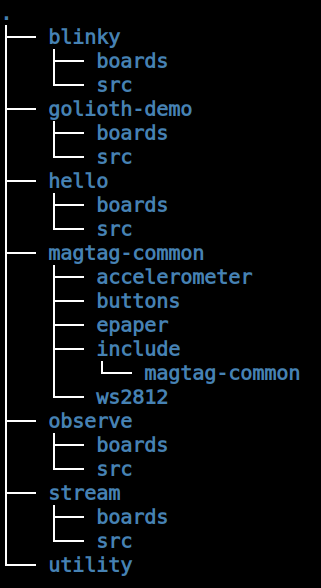One of the best tools in the Zephyr ecosystem is the ability to include different code modules in the build configuration. This feature leverages CMake and Kconfig, two tools that are core to Zephyr. But these tools aren’t limited to officially approved code modules. Today we’ll cover some CMake and Kconfig tricks for including common code in your own Zephyr applications.
The problem: common code across different variations of your app
Earlier this month we posted about the developer training that Golioth offers. It centers around a hardware development board called the MagTag, for which we’ve put together a code repository with many different examples. This includes code to drive the ePaper display, update four ws2812 LEDs, service button presses, and parse JSON objects.
The problem is that we need to use a common set of code in most, but not all of the training samples.
Luckily we’ve seen this problem before. The samples in the Golioth Zephyr SDK use common code for networking and shell settings features. Each feature from that common code has its own KConfig symbol, like GOLIOTH_SAMPLE_WIFI_SETTINGS, that is selected to include it in the build. By defining these in the board-specific conf files, libraries are only built for the devices that actually need them. For instance, an Ethernet-connected device doesn’t need WiFi settings.
The example from the Golioth SDK is a good one to study, but the MagTag implementation is a bit simpler so let’s walk through that code.
Directory Structure
 From the directory structure of the training you can see that we have five different Zephyr programs in this repository, each with their own
From the directory structure of the training you can see that we have five different Zephyr programs in this repository, each with their own boards and src subdirectories.
Common code for each app is placed in the magtag-common directory. Header files for each library are located in the the magtag-common/include/magtag-common directory. That might seem a bit convoluted, but it makes for sensible include names like #include "magtag-common/buttons.h".
Creating Kconfig symbols
Common code is individually enabled with a Kconfig symbol. There are a few ways to approach this. One of the easiest is to assign one symbol to indicate your app uses the common code, and then one symbol for each specific library in the common folder. This is done with a Kconfig file inside of the magtag-common directory.
menuconfig MAGTAG_COMMON
bool "Common helper code for Golioth MagTag Demo"
help
Build and link common code that is shared across MagTag samples.
if MAGTAG_COMMON
config MAGTAG_ACCELEROMETER
bool "Handle accelerometer readings"
help
Get accel from DeviceTree and write readings to shared sensor struct
config MAGTAG_BUTTONS
bool "Process button reads"
help
Configure buttons for interrupts with callbacks
config MAGTAG_EPAPER
bool "2.9\" grayscale ePaper driver"
help
Hardware driver for ePaper, including text and partial writes
config MAGTAG_WS2812
bool "ws2812 helper functions"
help
Intialize and update LED color and state
endif # MAGTAG_COMMON
From this code snippet you can see the library-specific symbols are only defined if the MAGTAG_COMMON symbol has been selected.
Using CMake to build in the libraries
Now that we’ve created the Kconfig symbols, a CMakeLists.txt file in the magtag-common directory is used to build in the code based.
zephyr_library_sources_ifdef(CONFIG_MAGTAG_ACCELEROMETER accelerometer/accel.c) zephyr_library_sources_ifdef(CONFIG_MAGTAG_BUTTONS buttons/buttons.c) zephyr_library_sources_ifdef(CONFIG_MAGTAG_EPAPER epaper/magtag_epaper.c) zephyr_library_sources_ifdef(CONFIG_MAGTAG_EPAPER epaper/magtag_epaper_hal.c) zephyr_library_sources_ifdef(CONFIG_MAGTAG_WS2812 ws2812/ws2812_control.c) zephyr_include_directories(include)
The include directory is added by default, but the source files are only added if the associated symbol is defined.
Using the common code in a Zephyr application
So far, the common code is completely separate from the each of the apps we want to build. Let’s use the golioth-demo app as an example. To tell the app about the common code, the subdirectory needs to be added to the CMakeLists.txt file in the application subfolder.
cmake_minimum_required(VERSION 3.20.0)
list(APPEND OVERLAY_CONFIG "../credentials.conf")
find_package(Zephyr REQUIRED HINTS $ENV{ZEPHYR_BASE})
project(lightdb)
add_subdirectory_ifdef(CONFIG_MAGTAG_COMMON ../magtag-common magtag-common)
target_sources(app PRIVATE src/main.c)
This codes makes sure that the common directory is only added to the build when the MAGTAG_COMMON symbol is selected. This completes the plumbing work. In this example, the app selects the common code in the prj.conf file:
# MagTag Common Files CONFIG_MAGTAG_COMMON=y CONFIG_MAGTAG_EPAPER=y CONFIG_MAGTAG_WS2812=y CONFIG_MAGTAG_ACCELEROMETER=y CONFIG_MAGTAG_BUTTONS=y
And of course, you must include the header files to access the library functions. Here’s an excerpt of the main.c from the golioth-demo app:
/* MagTag specific hardware includes */ #include "magtag-common/magtag_epaper.h" #include "magtag-common/ws2812_control.h" #include "magtag-common/accel.h" #include "magtag-common/buttons.h"
Wrapping up
Abstracting your common code makes it a lot easier to maintain. This approach also adds entries in menuconfig for each of the libraries. This is a user-friendly feature as it allows you to convey more details in the help file. For more complex uses (like the Golioth samples common libs) it also makes it easier to see the symbol dependency hierarchy.
This example shows the libraries as a part of the repository, however this will work just as well if you commit them to their own repo. From there, they can be included as a git submodule, or with a little creativity you can get your west manifest file to pull the repo whenever west update is run. This is the approach that we’ll be taking with future development. Doing so allows us to lock the project to a specific hash of the common code so that future changes don’t break application code.



No comments yet! Start the discussion at forum.golioth.io